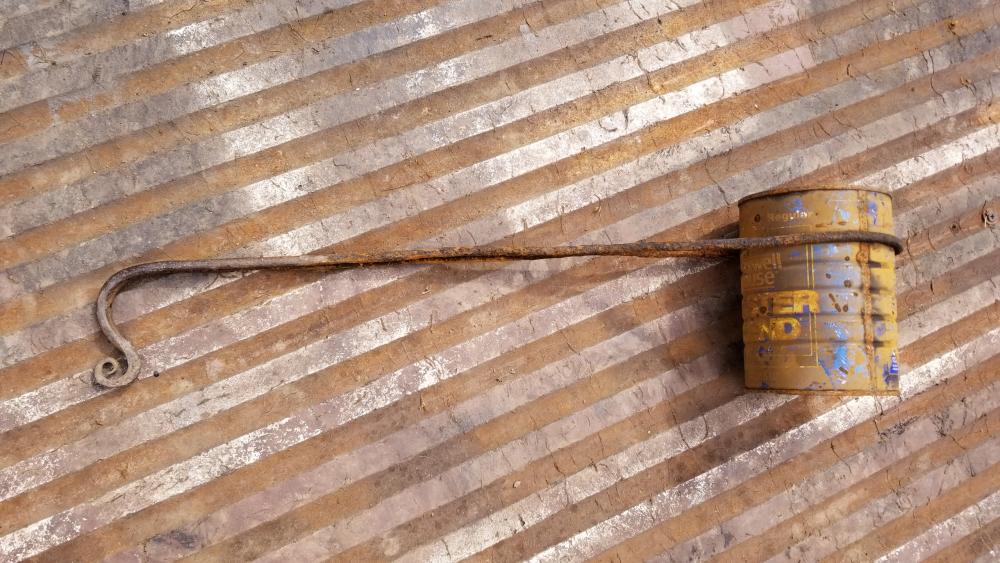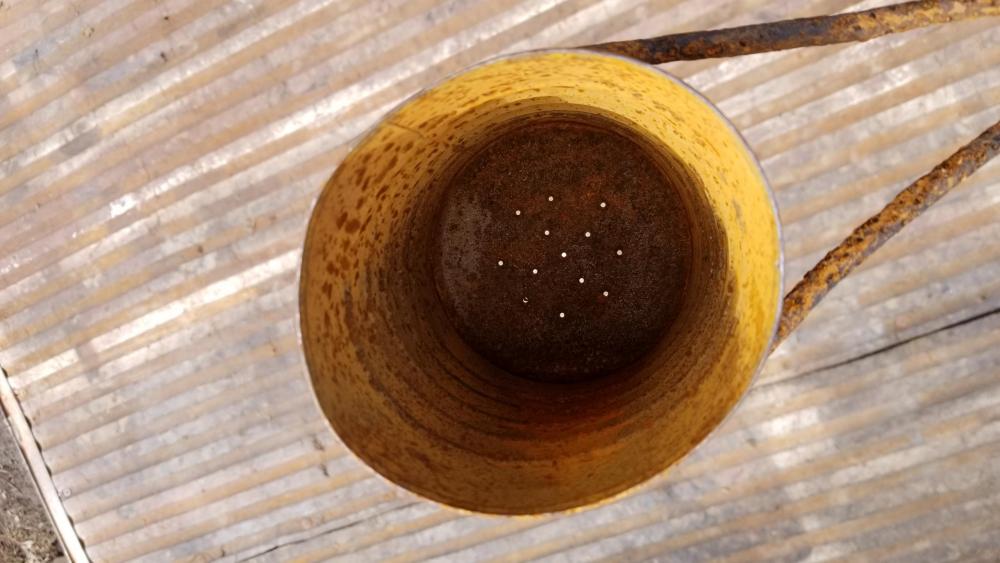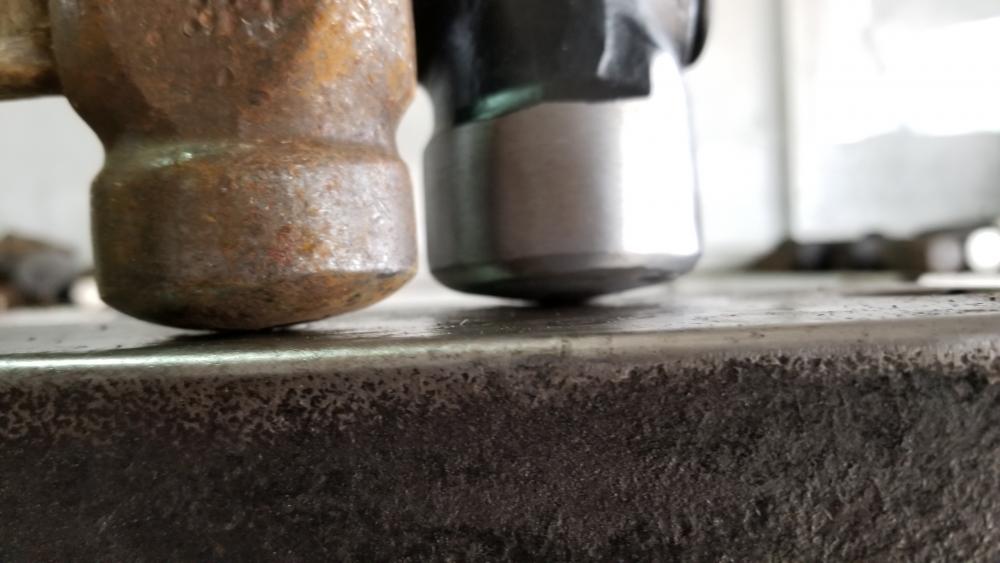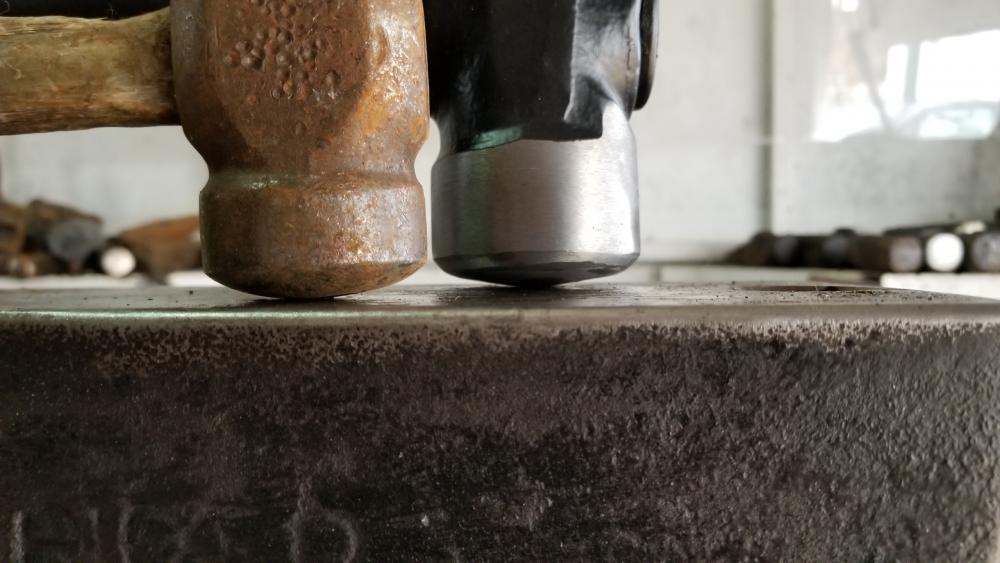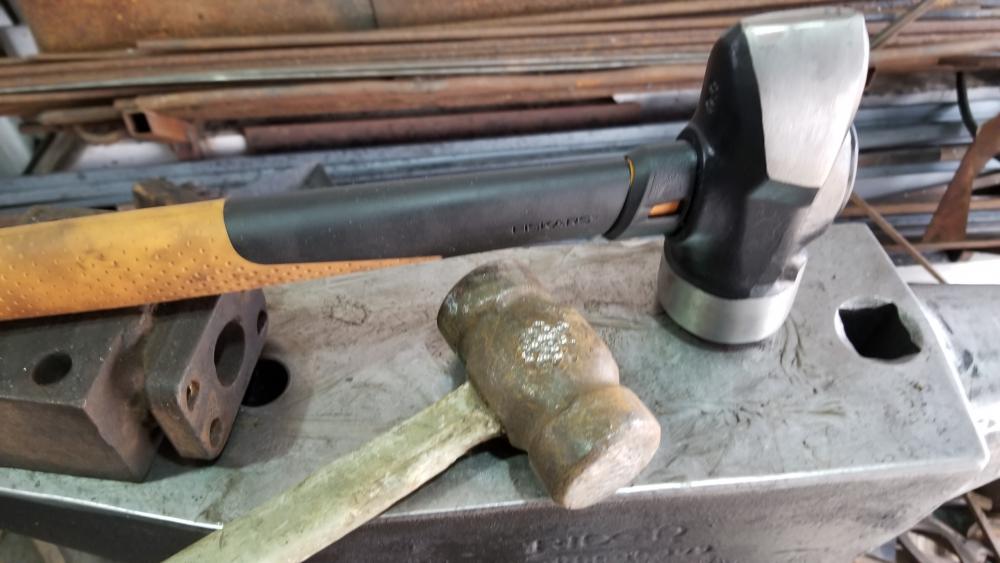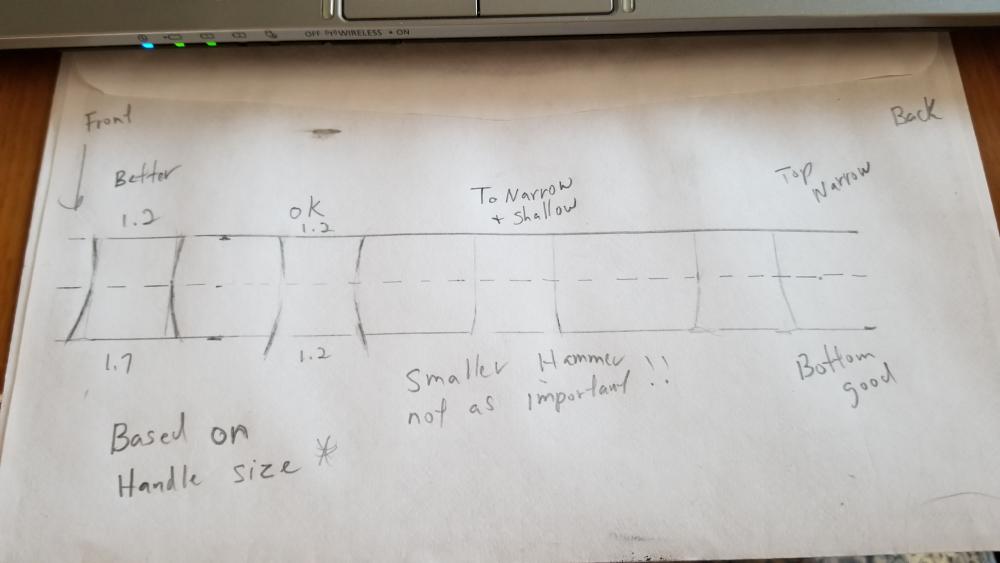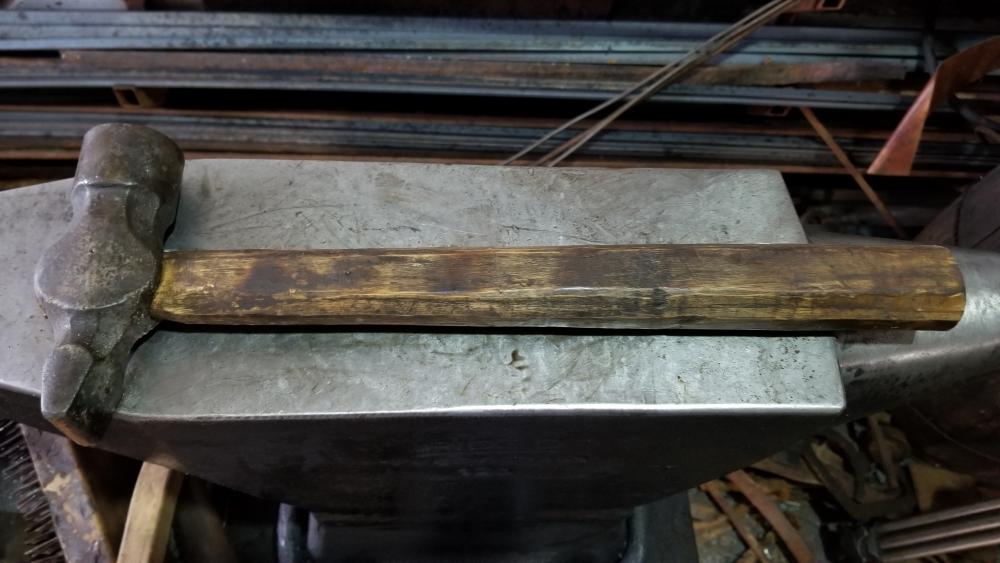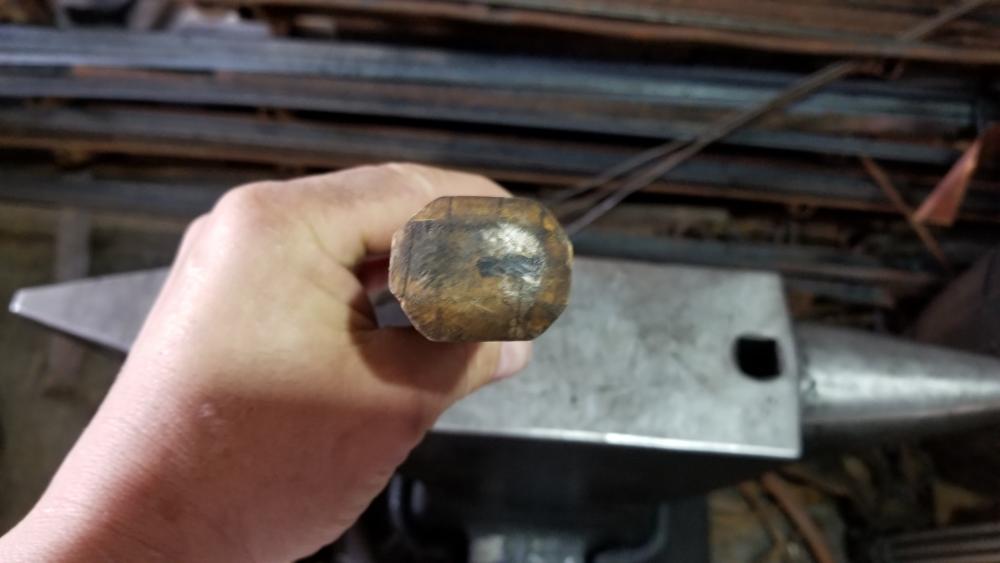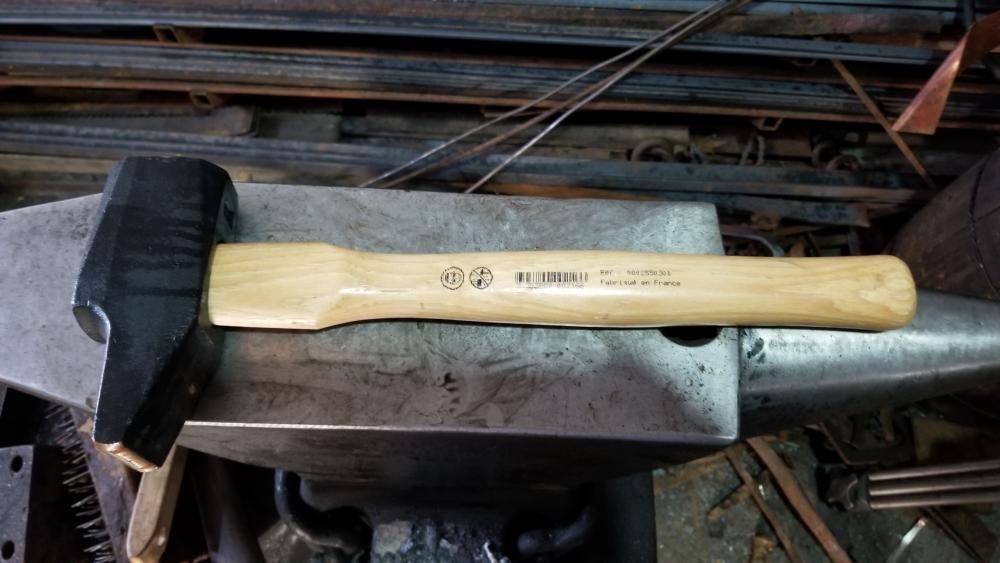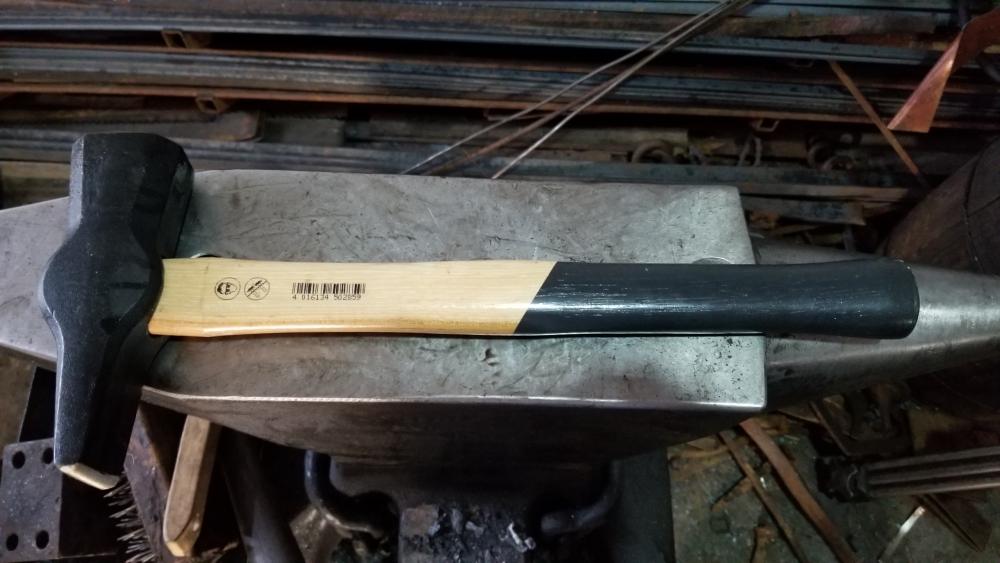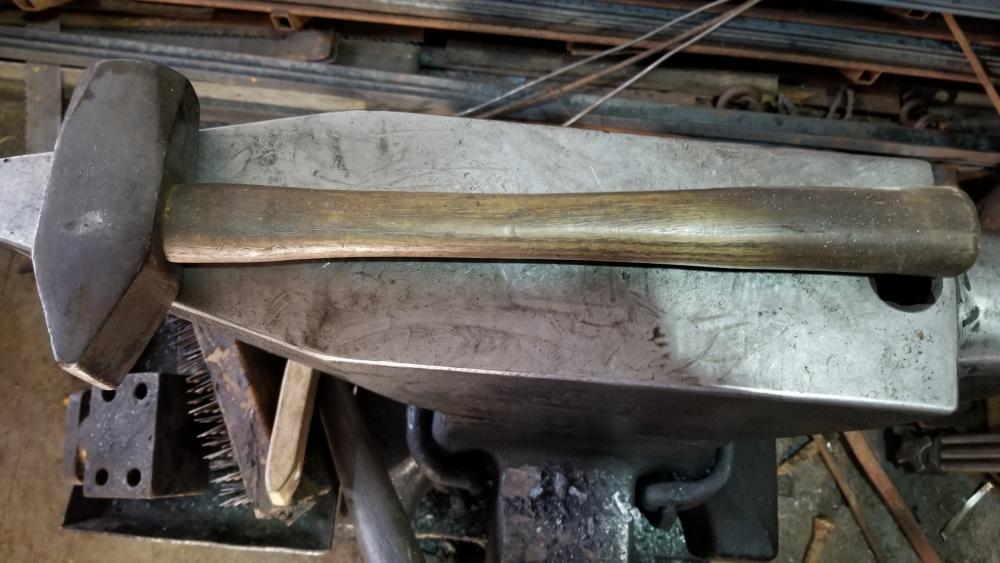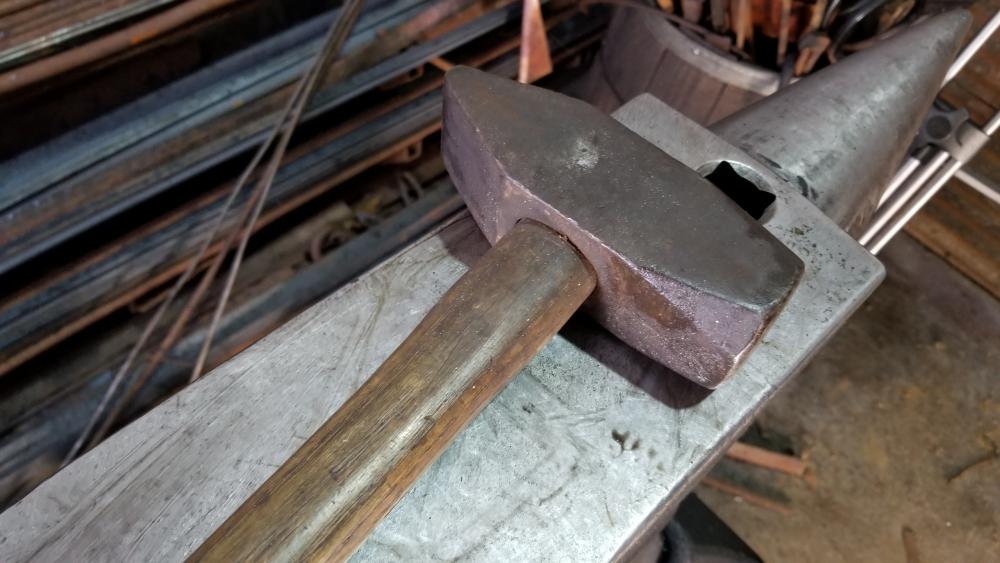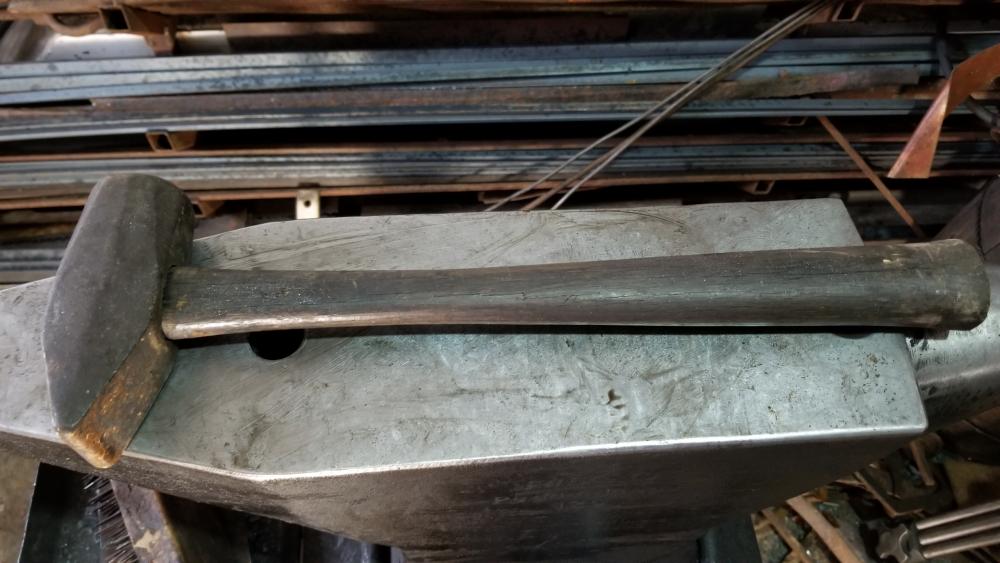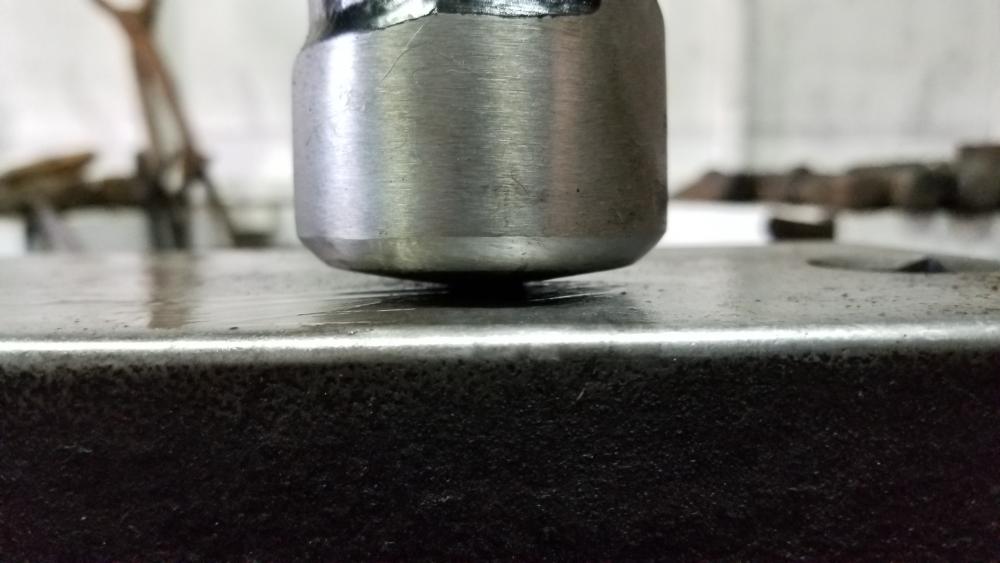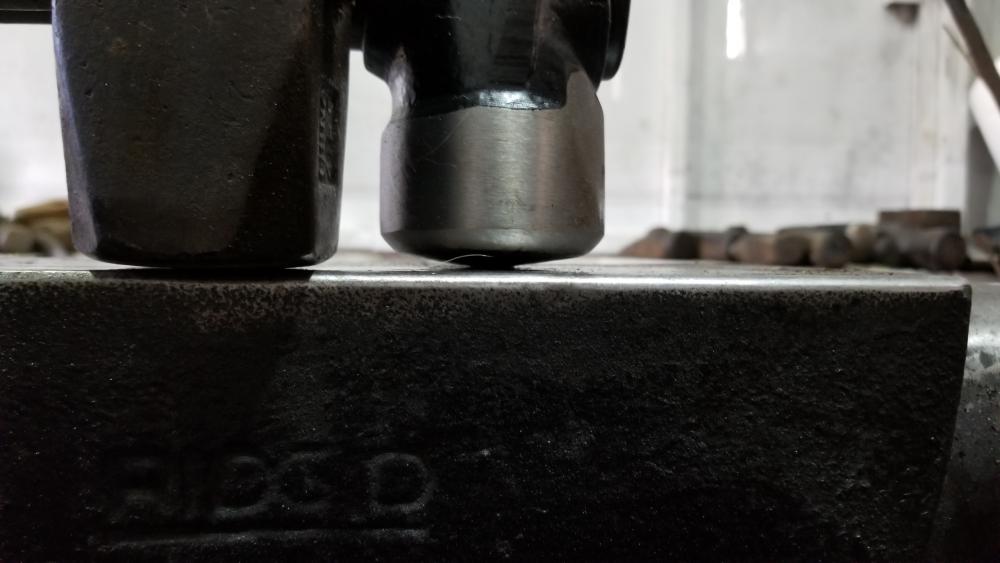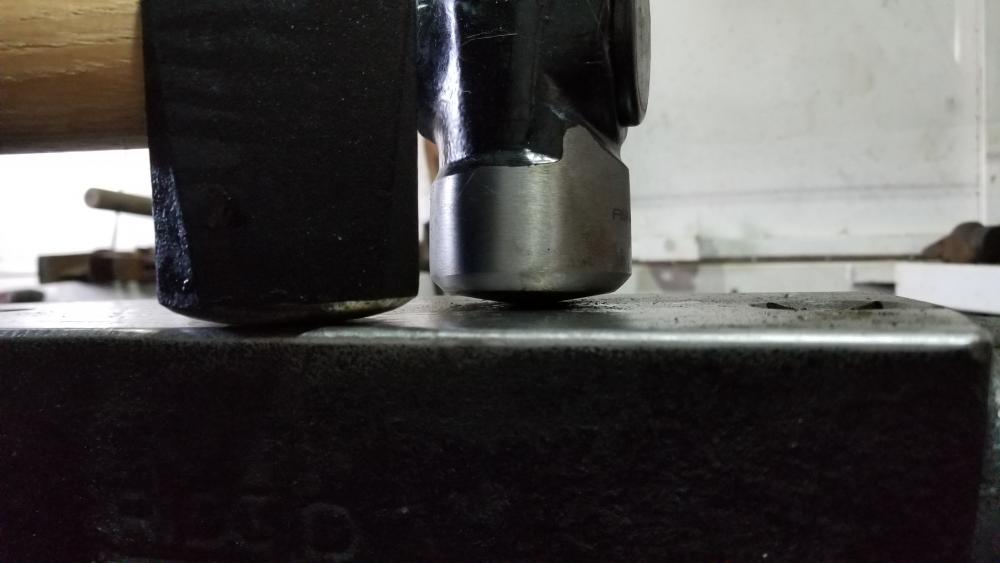-
Posts
5,776 -
Joined
-
Last visited
Content Type
Profiles
Forums
Articles
Gallery
Downloads
Events
Everything posted by jlpservicesinc
-
I use a 1lbs coffee can with the handle just so.. 98% of the time no matter how you throw it into the bucket its hook will grab the side of the tub.. I found any size smaller than this while handy (I do have one). is not as effective when needed to cool off larger stock sizes.. When you are trying to isolate a section in the middle of the bar and you can dip the rod into the slack tub having the extra water in the can comes in super handy as you won't need to stick the can back into the water which will disrupt the surface and change the water height splashing against the metal.. This was the 3rd design.. I started out much smaller and this was the final evolution 30 years ago.. Where I used to live the water was better an a can would last 6-7 years.. here they only last about 2 years if it is not stored in the tub..
-
1906 Need the measurements of the face and the hardie hole for weight.
-
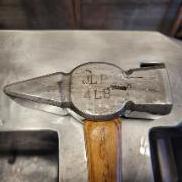
What did you do in the shop today?
jlpservicesinc replied to Mark Ling's topic in Blacksmithing, General Discussion
I'm a fan for reverse wheel work.. Steam bent rock maple outer runners held on with tire lock bolts, or a nicely laid tiger maple with a lighter colored stain or natural.. with just some poly on it.. Ive never liked the way a mushy rocker feels. (soft contact patch).. Looking forward to the progress.. Personally I feel items like this should have their own thread.. Documentation of methods and results could be helpful for others. -
So I dug out the rounding hammer and if the corners of Fiskars were rounded out and radius was smoothed to corners of the face the complete radius of the face would be pretty close to the rounding hammers.. It might be a picnic.. "Today is a good day to die".. As in there are no regrets..
-
Yup. A fierce hand is a proper hand.. cant let people step out of line.. what would others think..
-

What did you do in the shop today?
jlpservicesinc replied to Mark Ling's topic in Blacksmithing, General Discussion
Ausfire: , toes, kitty tails, doggy tails.. extension cords, Christmas lights, hardwood or soft wood floors.. Makes me wonder if someone has had a lot of rockers stolen or destroyed by family on game nights.. this will cure both.. Ranchmanbeb nice work.. all things said in jest.. i am curous about the rockers, the contact patch for a rocking chair is suppose to be pretty thin on the runners.. wood bolted to the metal? -
Frosty, the french and the fiskars is pretty close.. i was a little high when i snapped the pic, and since the french is wider, the shadow washed out the radius.. My rounding hammers geometry is probably 2x that of the fiskars.. I bet you could take a pound off pretty easily on the 4lbs.. maybe even more.. be curious what you get with the 3lbs? If the arthritis is flaring up the shorter handle of the 3lbs with material removed seems like it would be a winning combo... if you go that way, id love to see how much you take off with pics of the finished hammer.. As for personal/people: One does what one has to and as you have pointed out, its all about the fun.. If a 1lbs hammer works for someone.. more power to them.. This may or may not sound weird but, i have nothing set in stone..If a better way comes along i have no problem discarding the old for the new...(in terms of technique) every video i have made as well as information shared are merely suggestions on a way to do things based on years of self exploration.. Basically a (bubble blacksmith) with no outside influences.. kinda like rip van winkle.. Please let me know how the hammer works out.. Thanks..
-

Hammer head hardening help
jlpservicesinc replied to Ramsey26's topic in Heat Treating, general discussion
pto, drive shafts, axles an such can be 4140. 1045 or 1060.. If you thoroughly hardened the test piece and it didn't snap in the vise when hit it's probably 1045 or even 1030.. some of the less expensive pto shafts are made pretty cheap.. I use a more complex method for tempering hammer faces but I want my center of the face clear or bronze (hard, hard, hard) and the edges peacock or blue.. I use a close fitting ring made from 1".. Take a temp on the hammer about 200F then heat the ring up yellow and slide it over the face of the hammer.. I move it back behind the edge of the face and as I see the colors run I move it up.. removing the ring and quenching as the sides turn peacock/blue.. -
Thomas, true that.. The precept that something is made and is perfect is something that happened sometime ago.. It's one of the great things about being a blacksmith.. I can make anything into anything that pops into my mind.. Back in the 80's I had a few problems with factory handles failing as well as the heads coming loose from the handles.. It's what led me to to the research and I also discovered a buggered up eye, not smooth will hold a handle better than a well finished eye.. It went against everything I thought about as a finished item.. The only hand made hammers I have left are my Farrier driving hammers.. The guy who was my mentor hated my driving hammer because of the handle shape..
-
Take it for what it was/is.. Free.... I agree these probably should be moved to its own thread.. Because something is factory done a particular way doesnt mean its the best.. it simply means it meets the needs of consumers for a given time frame.. this is what happens with nearly all commercially made products.. that and most handles are pre processed or off the shelf.. especially today.. my farrier supply as well as most hardware stores carry the same type of handles for a given hammer style.. I have vintage staight eyed hammers.. they are ok nothing to write home about... again there are methods.. people do what they do. Information from trial and error leaves more insight for others to make there own decisions. Again i shared eye shapes for those who might want more info.. Handle shape, length or thickness as mentioned as my preferred is just that.. Only took me 30 years to figure it out for myself. I have noticed that smiths as well as farriers who have been at it awhile have a tendency towards thinner vs thicker with much less curvy then the handles shown on the commercial handles.. My main hammers all have nearly the same shaped handles. Only difference is eye size.. all the hammers except Thor are the same length. These were shown for shape and the transition area at the handle/head junction. Not as an example of handle shape to follow..:) My vintage Heller welding hammer takes a ball peen/engineers handle its 2lbs.. i bought 3 off the shelf at true value hardware 20+ years ago.. cheap, easy and fast.. i still dont like the handle as much as the first pic..of the engineers hammer. Charles i consider a 4lbs a hand hammer.. lol..
-
Die grinders work great either with a stone (hardened steel) or a burr for unhardened eyes.. I don't want to be nit picky but I always leave my eyes soft.. I only harden both ends.. FYI, there is a ratio for the part receiving the handle and there is also a ratio for where the wedge or top side of the handle.. This might be where I'm getting the 1.2 from.. It's been many years since I was involved with this and I will be at some point doing a Hammer making video and it will explain it in depth.. But for the time being here is a picture.. The ratios were based on my preferred hammer handle cross section.. Today I prefer a more evenly lengthed handle than the bulbous handles with lots of curves.. A full tapered handle works as well. Retangular with hard edges removed.. The french and swedish hammers are here to show what i definitely do NOT like.. Icky.. My 4lbs you can see the handle to head transition is nearly straight.. And then my 2lbs which the handle is nearly 30 years old and loose but has yet to come off.. LOL.. I am not a fan of having a Does foot or any foot on my hammer handles.. I can feel where the ends are by size and if my hands are that tired that I can grip the hammer, I just grab a smaller hammer.. The monster straight peen which I use in the Hinge series is nearly straight with no taper.. And lastly.. The taper at the top of the head if you get much above the 1.2 ratio the wood has a hard time expanding enough to fill the void leading to loose handles.. It's a mistake I made on the 2lbs hammer so handles while they don't break loosen up very quickly.. Every hammer I have ever bought I have redressed the eyes on.. There is also a side taper which is slightly less than front to back taper.. I also experiemented with Depth of taper and about 50% of head depth is about correct.. for a sq cross section like the regular hammers.. The squashed center sections are done that way to increase the amount of handle contact with the wood thus offering more support for the heads.. This 50% ratio for from bottom to top then increases from the bottom to 60 or even 70% up maintaining that 1.2-1.7 ratio.. This increases the amount of hammer handle surface area and transition to be made longer and stronger for a given handle size..
-
JHCC and Rancherman, while those are very nice looking hammers.. I keep seeing the same problem with the forging and handle fitting.. In a previous post someone showed a handle snapped at the head.. (Rancherman) This type of failure on a new handle is simply because the hole is to small And/or the fitting of the handle leaves that sharp demarcation between the handle and head.. Completely remove the wood to form a straight and flexible shaft below the head or make the hole in the hammer larger to accept the handle with no obtuse handle angle.. The area of the handle leading into the head has to be spread over a longer gradient.. With this type of design the head/handle will fail prematurely.. There is a ratio of punched hole size in hammer heads to handle diameter.. It became a common sense thing over the years, but it seems it has never been mentioned in any of the information I have seen on any of the BB or AS videos.. No offense to anybody but the ratio for maximum life in the hammer to handle IIRC is like 1.7.. I can't remember the exact ratio but for some reason this comes up as the first guess.. Might be 1.2-1.7..
-

Opinions on Columbian Anvil
jlpservicesinc replied to Baldncane's topic in Anvils, Swage Blocks, and Mandrels
Congrats. Now your ready to go in nearly 1fell swoop. -
The mod's keep a tight ship.. It's what keeps it organized and family freindly.. JLBlohm, I wouldn't be overly concerned either.. I used to get quizzed quite often but once you become a known entity and show both patience and skill/knowledge they allow you just enough rope to hang yourself.. LOL.. With that said people here also do really well with an apology where needed... So if something gets said in the heat of discussion or erroneous facts usually a fess up is all it takes..
-

Quenching in old motor oil
jlpservicesinc replied to Glenn's topic in Heat Treating, general discussion
The romans used it to whiten their teeth.. -
from the earliest days they were pretty much always cut.. Be it by hand with chisels or files or with metal lathe with bits.. One of the most interesting things about screw boxes on these vises is they use square threads vs acme.. Sq threads have a higher work load with less inherit binding vs acme or any other thread.. A sq thread only keeps the faces in line vs a taper of a thread which becomes tighter the more friction is applied.. The cutting of sq threads is considered by most machinist today to be nearly impossible (very problematic) that 99.95% of them will tell you to just use acme vs the difficulty of producing Sq threads on the lathe.. it might be different now with CNC but years back I wanted to get a screw newly threaded and out of 50 machinist not 1 of them would cut me a 2 thread per inch sq thread.. They said it was ludicrous.. the back spacing of the thread and the lead angle of the bit are paramount to get a good sq thread.. A 2 threads per inch uses 1/4" wire wrapped around and this is then placed into the box and fire brazed in place.. Technically making it a lifetime box as when worn it can just be bored out and done again.. Anyhow, I never did locate anybody and even a close friend of mine who worked at Wyman-Gordons told me it wouldn't be worth his time and just to do Acme.. I now own a lathe so at some point will take on the challenge of producing a thru square thread.. All the old machinist books show how to cut them but no modern guy wants to take on the job.. I figure when I forge my 10" Super giant German Style vise I will take on the calling..
-

Opinions on Columbian Anvil
jlpservicesinc replied to Baldncane's topic in Anvils, Swage Blocks, and Mandrels
Yup, what he said.. I own a 200lbs and it's very nice. -
Charles did you have to bleed the lines once installed? Shiny..
-
Update.. here is the level of roundness in the face.. You can see the difference between my regular 4lb german and the fiskars.. the German is nearly flat, it's showing an angle or gap as I had to rest the handle on the punch block.. BiggunDR: I've made thousands of nails.. And nearly all of them were used for installation of hardware.. I did make a bunch for a person once that used them in the conventional way of putting planking together to form a door.. He nailed 3 layers of white oak together and the nails were clinched on the backside.. No glue used just the nails.. All onside pyramid nails, with 3/16" shanks.. What a beautiful door.. Weighed like 350lbs when finished.. Pm me your address.. I'll send you over a few to use. I personally in my original shop it had old fashioned brick and mortor and I'd use the forged nails between the bricks and they held amazing well.. I also used hand forged nails for all sorts of stuff and still do.. I had someone out for a lesson and needed a couple of spikes to hold the anvil to a stump I had them bring.. I made the 2 spikes and then I had a 9 year old kid make a few.. He was pretty talented and knocked out some nails of his own in short order.. With the way things are today it's actually not worth it to use hand made horse shoe nails.. The liability alone if used on a customers horse could be a huge problem if the horse abscessed and the nail wasn't even the culprit.. New nails I'm sure you know are cleanly polished.. any nails with rust are to be thrown away or cleaned in such a way as to remove all the rust.. BeCu is kind of a rare bird in most circles... I only know about it because the Bandsaw blade welder on my DoAll band saw uses the material and I wanted to make a new set of upset jaws for rods.. I priced it out (rediculous) I needed a section like 3X4X4" in 2.. I then posed the question of cost to another site I frengent and they filled me in on the dangers.. Lots of older gents who have been there and done that.. I decided I wouldn't bother.. The last picture is of the comparison between a french cross peen and the Fiskars.. Frosty there is plenty of material to remove if you really wanted a lighter weight.. As you mentioned the peen actually flares out a lot so just removing and cleaning it up would help..
-
Thanks.. If I ever take my show on the road "you guys" will give me a route to follow..
-
Yup, Crazy yankee girl is gonna get herself killed.. To get it into the car I walked it up a 2X12" oak plank I brought with me.. LOL.. I put the back seats down walked it up onto a piece of plywood and used the seat belts to strap it in.. We have rolling hills here.. We call them Mounts when they are big enough or just interesting.. But where I was out there it would have taken a day to walk up them. It was really Beautiful.. Here unless it's MT washington or another 4000footer up north .. We can walk in pretty much any direction and run into another road in maybe 20-25minutes if you know how to walk straight.
-
Yes that is a little bit out of the route.. I was out there a few years ago picking up the 368HB anvil.. Nice country out that way.. I was so surprised to see all the gas lines everywhere and gas just burning on the side of the road.. Maybe it saves on electrical costs vs a street light.. Waynesburg is where it was. Just really beautiful.. I was also surprised at all the mountainous terrain and then the top of the mountain around the corner was missing.. I really like driving through the country side out that way.. Really just some pretty areas.. Your terrain is much different than around here.. On my way back I noticed i was riding the rim of a valley and it was a clear enough day i could just about see to the other side.. Must have been 25miles across easily.. On the way back the GPS sent me south into W VA an then back up into PA.. Me and the HB.. Loaded into the back seat of the Audi A4.. When I showed up the Guy and Gal who sold it to me said and I quote" Your crazy.. That anvil is nearly as big as your car.. How you gonna lift it in there? How far yah come? Good luck with it.: And God bless as I closed the door and headed off.. that little 1.8L turbo wasn't happy on all the hills.
-
I sure will.. I believe I will be going down 84 to 78, 81.. Not sure of which day I'll leave as I'll be spending about a week with family..
-
Big gun Dr. I have made horse shoeing nails.. I have never actually used any of them.. The old fashioned hand made nails unless made from wrought iron are tough to use.. Modern horse shoeing nails are made from a very soft steel so are easy to clinch.. They are also sheared on their tips so they are very sharp and this controls where the nail will come out.. If you are asking about hand forged nails... Or just plain old hand forged nails vs horse shoeing nails there is a huge difference among all the different types.. Horse shoeing nails are very sharp and will drive into pine or other soft woods pretty easy as they are very much the same consistency of hoof wall.. Hardwoods on the other hand the nails just bend.. Again they are designed to bend in use.. The nail is driven into the hoof and then is strategically bent over (clinched) is a special way as to ensure a good grip.. Ideally a clinch should be square in shape when finished.. Anyhow, If you are looking for just a square shank nail or a nail with a fancy shank Square, triangular.. or rectangular it is very easy to make a header for just such a thing.. Old hand made shoeing nails depending on the type of shoeing might have a raw head or a swaged head depending.. If left raw you can be just about certain they were wrought iron as they would mush to fill the punched voids.. Beryllium Copper is a very hard copper alloy.. It is a high heat alloy and used for high temp/ high current applications.. The only way I have ever found to do anything with it is to machine it.. Be aware the dust is supposed to be highly reactive and cause cancer.. If you are referencing just a square shanked nail as a horse shoeing nail, they are 2 different nail types and designes.. The latest video on using the hammer is on nail making.. The Nail making video on this subject is covered pretty well on the JLPservicesinc youtube channel.. With hand forged square shank nails the nails are designed for the materials they are going into.. If a wrought iron nail is used on hardware and will be clinched on the backside they are left completely soft.. If they are going into dried hardwoods the shanks will be cold forged to make them work hardened, There are spade tipped nails vs just pointed, spiral nails, roofing, slate, etc, etc, etc.. If you want more info let me know..

